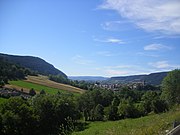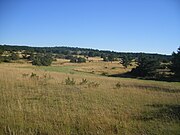Chanac
| Chanac | ||
|---|---|---|

|
|
|
| region | Occitania | |
| Department | Lozère | |
| Arrondissement | Mende | |
| Canton | La Canourgue | |
| Community association | Aubrac Lot Causses Tarn | |
| Coordinates | 44 ° 28 ′ N , 3 ° 21 ′ E | |
| height | 612-1,004 m | |
| surface | 71.14 km 2 | |
| Residents | 1,455 (January 1, 2017) | |
| Population density | 20 inhabitants / km 2 | |
| Post Code | 48230 | |
| INSEE code | 48039 | |
| Website | http://www.chanac.fr/ | |
 Village view |
||
Chanac is a French commune of the department Lozère in the region Occitania . Administratively it is assigned to the Arrondissement of Mende and belongs to the canton of La Canourgue .
geography
The core of the mountain village with 1,455 inhabitants (as of January 1, 2017) lies on a rock spur above the Lot Valley at an altitude of 650 meters, around 100 kilometers north-northwest of Montpellier . Part of the municipality (including the hamlet of Le Jas ) is located at a good 1000 meters on the Causse de Sauveterre plateau . The municipal area is very large with over 71 square kilometers and the population density is low, as in the entire Lozère department. The people of Chanac speak mostly Occitan in everyday life .
history
coat of arms
Blazon : Square: In the 1st and 4th field - three golden roses on red; in the 2nd and 3rd field - bars of gold and azure divided five times; above everything in the middle of the shield is a black eagle in silver.
Population development
| year | 1936 | 1946 | 1954 | 1962 | 1968 | 1975 | 1982 | 1990 | 1999 | 2009 |
|---|---|---|---|---|---|---|---|---|---|---|
| Residents | 976 | 955 | 826 | 892 | 866 | 988 | 1,019 | 1,035 | 1,153 | 1,376 |
Attractions
The dolmen of Laumède (also called l'Aumède or Lo Geïon) is located southeast of Chanac.
Chanac Castle
description
The medieval castle in the historical Gévaudan landscape is located on a promontory on the Lot, on a rocky promontory. It was held for a long time by the bishops of Mende . Today only the donjon , a tower and the remains of the fortification walls remain. The greatest damage occurred during the French Revolution when the fortress was set on fire. Chanac Castle has been a French cultural monument since 1993 .
history
The castle of Chanac near the fortress of Grèzes was probably built by the kings of Aragon to secure access from the Lot to the Causse de Sauveterre plateau. The building was built sometime in the years 1190 to 1210. Around 1220 it came into the possession of Guillaume de Peyre , Bishop of Mende, probably during the Albigensian Crusade . The bishop had the donjon built, which is still visible today. The castle then served as the residence of the Bishops of Mende for several centuries. It was one of the few fortresses in the Gévaudan province that was not taken by the English during the Hundred Years War .
In the wars of religion , the castle was fought over hard between the Catholics and the Huguenots . In the years 1580 and 1581 the Huguenot leader Mathieu Merle was master of the castle. In the meantime it was returned to its legitimate owner, but in 1591 it was temporarily taken by Philibert d'Apchier . He was Baron von Gévaudan and advocate of the League before leaving the League and recognizing Henri IV as the new King of France after the latter converted to Catholicism.
On August 24, 1696, a great fire destroyed the castle and with it the houses of Chanac. Bishop François-Placide de Baudry de Piencour then had it rebuilt, taking care to improve the comfort of his residence. It was also he who transformed Dijon into an "ice tower". From then on it was filled with ice from the Lot in winter, which could then be used to cool food in summer.
From 1767 Jean-Arnaud de Castellane , Bishop of Mende, was the owner of the castle. There he entrenched himself during the French Revolution in the years 1790–1792, before he decided to flee abroad, in which, however, he was caught and then executed. The castle was then occupied by the revolutionaries. But the Gévaudan counterrevolutionaries took the castle under the leadership of Marc Antoine Charrier on May 30, 1793. Just three days later, the Republicans retook the fortress and set it on fire that same night.
Ressouches Castle
The Château Ressouches is located in the historic Gévaudan landscape down in the valley to the west of Chanac on the right bank of the Lot. The castle was built by the bishops of Mende in the 16th century on their fief in Ressouches. It probably replaced a fortified house from the 13th century, which went back to the kings of Aragon and can only be guessed at today.
In the middle of the 17th century, the castle came into the possession of Antoine de Buisson , who first had it extensively renovated and then integrated it into his neighboring estate . The adjoining chapel also dates from the 17th century. There you can find the coat of arms of the Pont de Ligonnès family , who owned the castle for a long time. The most famous representative of this dynasty was Charles du Pont de Ligonnès , who was Bishop of Rodez and Vabres between 1906 and 1925 . In the 19th century, the estate was enlarged to include the stables next to the chapel. Today Chantal Bazin de Jessey is the owner of the property. The Ressouches Castle has been a French cultural monument since 1992 .
Other facilities
- The parish church of Église Saint-Jean-Baptiste from the 18th century
- The fortification of Villard ( L'ensemble fortifié du Villard ) has been a French cultural monument since 1998.
Individual evidence
- ↑ Entry no. PA00125498 in the Base Mérimée of the French Ministry of Culture (French)
- ↑ Entry No. IA00133655 in the Base Mérimée of the French Ministry of Culture (French)
- ↑ Entry no. PA00103812 in the Base Mérimée of the French Ministry of Culture (French)




